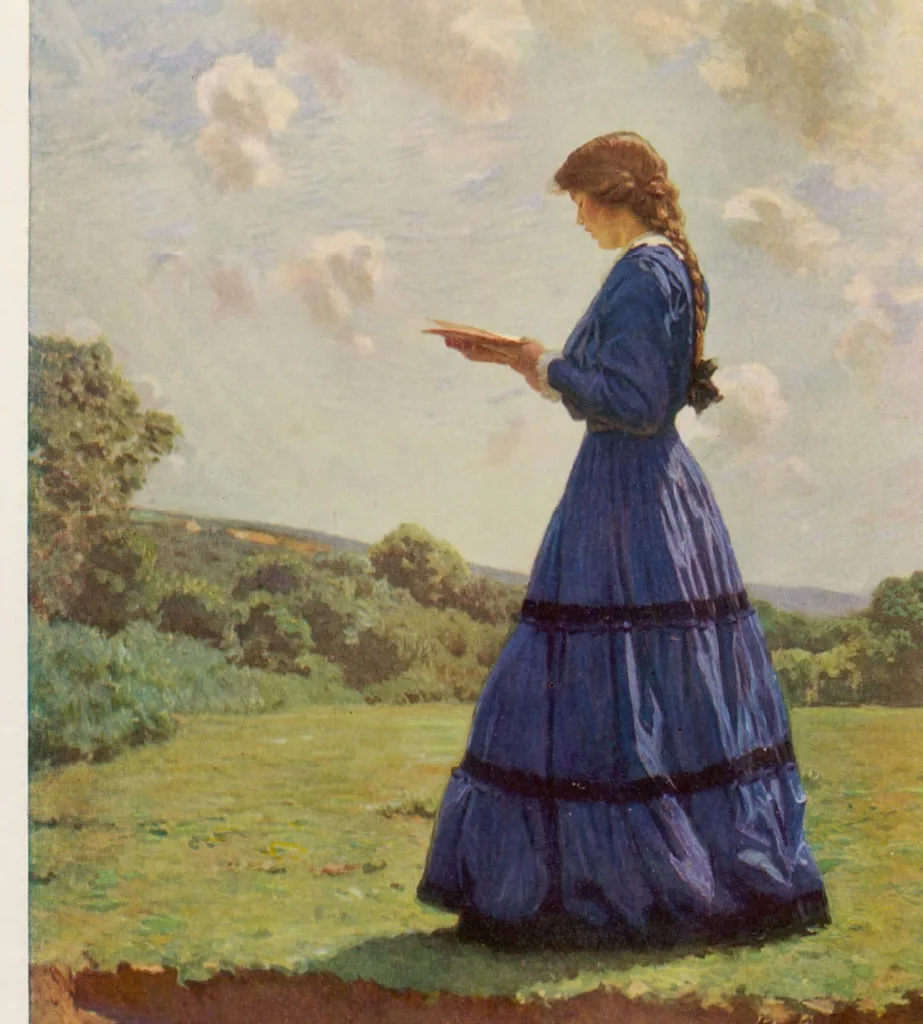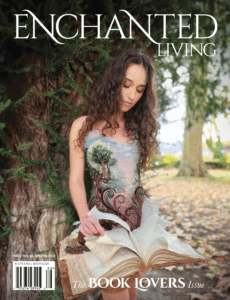Are you, like me, a passionate collector of the printed word?
Do you share my somewhat problematic tendency to acquire more books than your bookshelves can properly hold, more than you can possibly read in a timely manner? In my collection you’ll find novels read for pleasure, coveted antique classics, and literary resources for my passions for herbalism, foraging, witchcraft, art, cooking, and more. I must find ways to cleverly store books on bedside tables, in charming baskets and old wooden boxes tucked beneath furniture, and as decorative stacks woven into my home’s decor.
If you happen to share my predicament, I am here to tell you that your library of treasured books need not ever collect the dust of time. They can continually assist you in your spiritual growth. You can draw on their magic to obtain guidance, inspiration, and wisdom.
I’m assuming you are familiar with the practice of divination: the intuitive art of connecting to Spirit (yours included) to discover hidden knowledge and insight. Among the different divinatory practices are cartomancy (tarot and oracle card reading), scrying by gazing into a reflective surface like a crystal ball, tasseomancy (the reading of tea leaves), and bibliomancy (prophesying with books).
The basic idea of bibliomancy is to take any book of your choosing, close your eyes, open to a random page, and drop your finger down on the paper. The word, phrase, or passage you land on serves as inspiration or guidance from a higher place. Prior to opening the book, you could ask a specific question or just be open to receiving general information.

The History of Bibliomancy
The word bibliomancy comes from biblio, meaning “of or relating to a book or books,” and mancy, which translates to “divination by means of.” It is a tradition that dates back to the ancient Romans and the use of sortes to predict one’s future. Sortes were small tablets, usually made of wood, upon which were written lines from celebrated poets. Verses from Homer’s Iliad and Odyssey, and Virgil’s Aeneid, were especially popular.The tablets were thrown like dice or placed in a sitella (an urn) filled with water. Whichever verses turned up when cast like dice or drawn from the water were messages applicable to the life of
the person seeking the advice. The same practice was also common among early Christians, who consulted the Bible instead of secular verses—a practice known as sortes biblicae.
Lucius Tarquinius Superbus, the last king of Rome, who reigned from 534 to 509 B.C., practiced bibliomancy using The Sibylline Books, a collection of oracular versus in Greek hexameter purchased from a sybil (an oracle). But the practice of bibliomancy survived into the modern age, surging during the Edwardian period, particularly among the British.
In both the Victorian and Edwardian eras, it was customary to give a book to celebrate significant occasions like birthdays, weddings, or anniversaries, or to ring in the New Year. In fact, Edwardians held a superstitious belief that it was unlucky not to have a book in hand when the clock struck midnight on New Year’s.
Edwardians embraced the idea that books could foretell the future for oneself and one’s family. On New Year’s, it was common to engage in bibliomancy, with the head of family (usually the patriarch) opening their new book to a random page and reading a passage to predict their family’s future for the coming year. Popular books for bibliomancy in this period included much-loved classics like Westward Ho! by Charles Kingsley, Robinson Crusoe by Daniel Defoe, and Pilgrim’s Progress by John Bunyan.
Bibliomancy in Contemporary Practice
I prefer to get somewhat creative with my modern-day bibliomancy. The basic intuitive process is the same: Have a question in mind, or be open to receiving a general message meant for you. Choose the book that calls to you, close your eyes, feel the energy, and drop your finger down on the word, phrase, or passage meant for you. You will intuitively know which one.
As a psychic medium, I know that there is energy around certain things that are meant to happen but that nothing is set in stone. Therefore my advice is to use bibliomancy not as a form of fortune-telling but as a way to receive spiritual guidance and higher wisdom as you exercise your gift of free will.
It’s important to create a sacred space that’s conducive to receiving enlightened information. Light a candle, play soft music, bring in crystals and flowers (I love spring lilacs, as they enhance connection to the spirit realm), close your eyes, feel
your breath, and imagine your beautiful energy connecting to the ether.
When selecting your book, you can choose a novel, poetry, a classic, a book customarily used in the past for bibliomancy, a work of nonfiction, or even a dictionary. You can also look to your favorite author for guidance.
Expanding Upon the Traditional Practice of Bibliomancy
Traditional bibliomancy can be likened to drawing an oracle card or doing a one-card tarot pull. With tarot, though, a variety of spreads require multiple cards, so why not try something similar with bibliomancy?
Three-Passage Reading
The most popular three-card tarot spread is the past-present-future card spread, which is generally used to gain a better understanding of self or a situation. We can implement this same structure in bibliomancy. For example, I conducted a three-passage reading with my treasured 1852 copy of Nathaniel
Hawthorne’s The Snow-Image, and Other Twice-Told Tales. For this particular reading, I chose to receive general guidance.
Past: “and mingle my spirit with the wildest of the confusion”
Present: “Instead of the rich man’s wealth and the warrior’s sword, he had but a tongue, and it was mightier than both.”
Future: “the clear sky over my head, and the afternoon sunshine falling gently bright through the window frame and doorway. I heard the tinkling of a cowbell, the twittering of birds, and the pleasant hum of insects.”
Five-Passage Reading
A five-passage spread (based on the traditional five-card spread) is a great option if you want to dig a little deeper. The first passage represents your current situation, and the second represents your response to it. The third represents what is holding you back, and the fourth shows what you can do to change the situation. The fifth passage reveals the likely outcome if you make that change.
Further Tips:
• Think about how the words you land on speak to you personally. The information you receive will most likely be symbolic, not to be taken at face value.
• If the text you land on feels wrong or does not speak to you on an intuitive level, just try again. People often do this when drawing tarot cards. But keep in mind, just because something is seemingly negative, that doesn’t mean it’s bad. Sometimes the most important growth comes from a challenge.
• Don’t feel married to doing traditional spreads. You can make up your own, tailored to your own needs.
• Also, it’s a good idea to take notes in a designated journal, especially if you are doing a multipassage reading and want to remember the information given to you. Jot down the actual words from the book, as well as any intuitive thoughts and impressions you receive. The journal makes a wonderful gift to self—one that you can look back on, reflect upon, and use to witness and celebrate your personal growth.






























 Enchanted Living is a quarterly print magazine that celebrates all things enchanted.
Enchanted Living is a quarterly print magazine that celebrates all things enchanted. 
